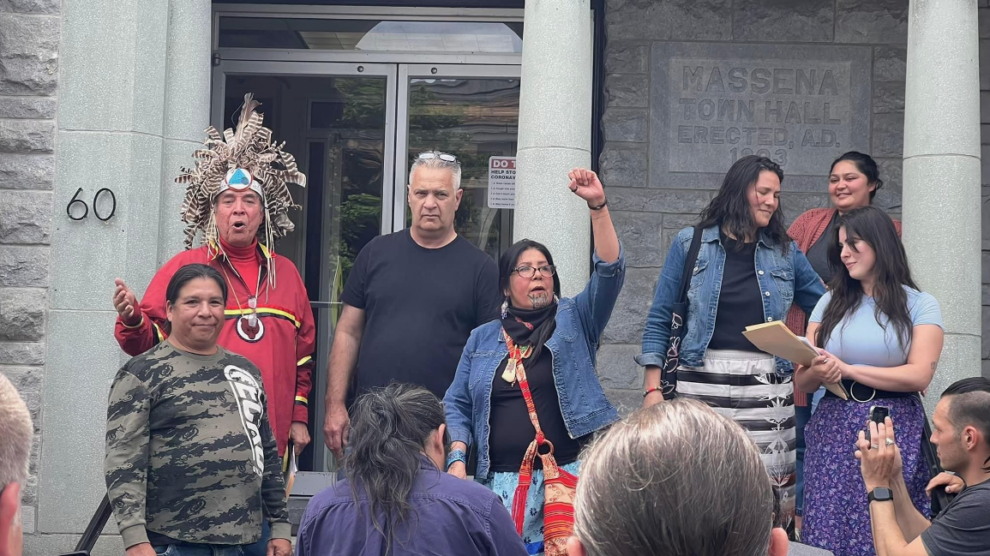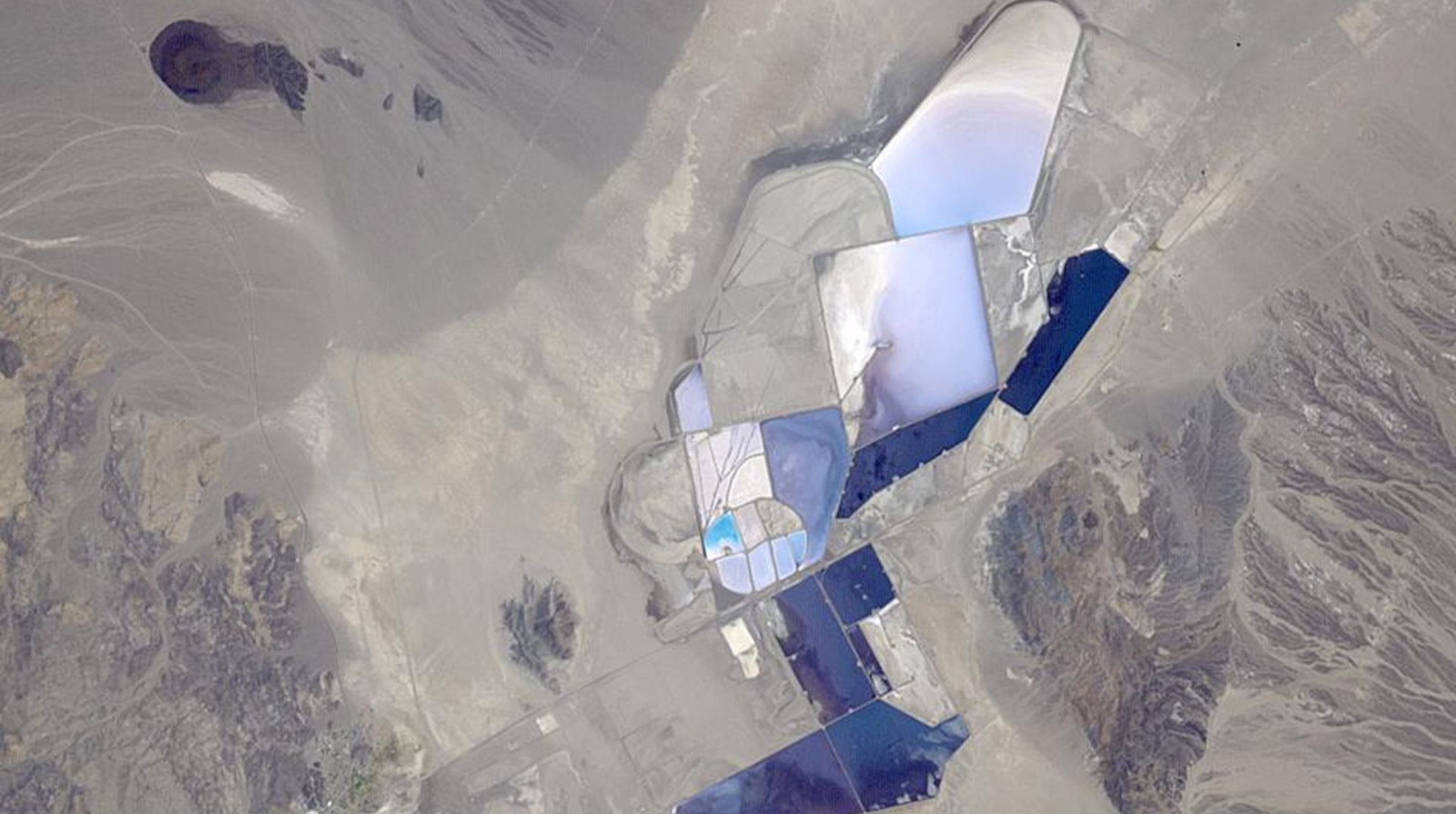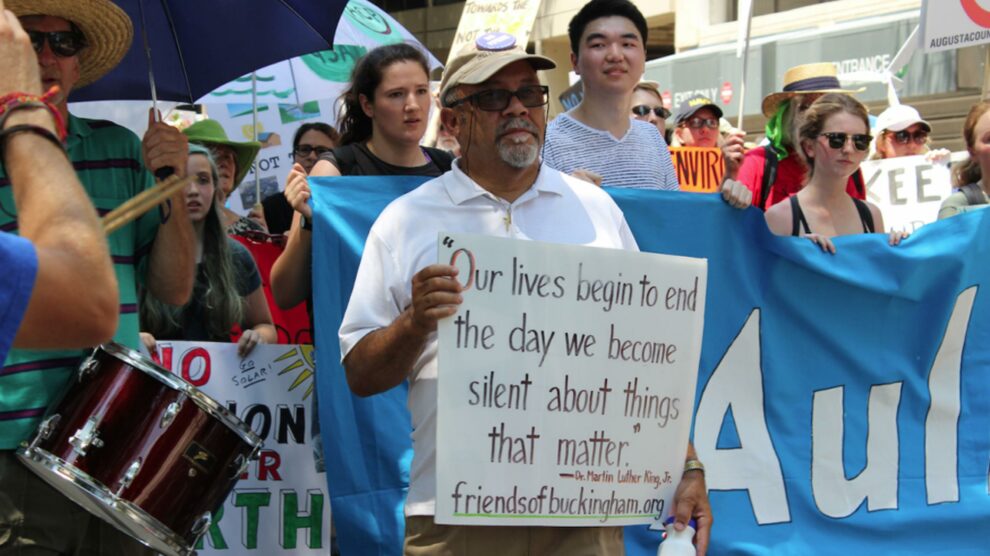Nine Ways Scientists Can Support a People’s Green New Deal
By Zach Zill
Volume 22, number 1, The Return of Radical Science
In late 2018, the Green New Deal (GND) vaulted into the center of US politics thanks to Rep. Alexandria Ocasio-Cortez (D-NY) and the young activists of the Sunrise Movement. Since then, the GND has become one of the most hotly debated issues in mainstream politics and has helped inspire an upsurge in climate justice activism and organizing.1
There has long been scientific consensus that climate change is real, that it’s happening due to elevated levels of carbon dioxide and other greenhouse gases in the atmosphere, and that human activities are responsible. Now the political discussion on climate change has entered a new phase. No longer focused on building consensus with right-wing forces who have no interest in acknowledging the science, climate advocates are building power—and forcing the political system to respond.
The science of climate change has long told us what we shouldn’t be doing. Oil, coal, and gas combustion emits carbon pollution; we must therefore stop building infrastructure that enables the extraction, exchange, and large-scale use of these fuels. In our capitalist economy, a handful of large companies drive the vast majority of carbon-intensive activities.2 Thus, we must pressure large investors to divest from fossil-intensive stocks.
Last fall, nearly one hundred scientists from dozens of countries, drawing on the work of thousands of researchers and practitioners released the Intergovernmental Panel on Climate Change (IPCC) Report. The IPCC Report underlined that radical action—not slow technocratic tweaking—is needed to address this issue. As it states, “Limiting global warming to 1.5°C would require rapid, far-reaching and unprecedented changes in all aspects of society.”3
Ocasio-Cortez’s (AOC’s) Green New Deal resolution begins to sketch out a blueprint for those “rapid” and “unprecedented” changes.4 It has sparked a mainstream discussion about a government-led plan to remake the economy,5 transition off fossil fuels, create millions of jobs, redistribute wealth, and empower workers, all while taxing the rich and reinvesting resources in publicly owned and democratically controlled assets.6 It’s also brought new prominence to the longstanding evidence-backed argument that environmental ills disproportionately impact certain groups of people in North America, especially people of color and Indigenous people.7
This discussion is long overdue. Yet the pressures on climate advocates to be “realistic” and drop the more controversial aspects of the Green New Deal—those that empower marginalized groups such as Indigenous communities, Black people, and migrants—will be significant.8 So too will the pressures to “leave it to the experts”; in other words, to divert the planning for a Green New Deal into more conservative, slow-moving political and technocratic channels.
That’s why Science for the People has launched a People’s Green New Deal (PGND) campaign.9 The PGND campaign aims to build a critical mass of technical experts to work in conjunction with activists and grassroots organizers. Together, we will acknowledge that the technical is political and expose false climate solutions. We will further insist that racial justice and popular control over the Green New Deal process must not become secondary considerations.

A People’s GND is necessary to remind us of the lessons of the original New Deal. Without putting racial justice at the center of the discussion, a massive government mobilization of social resources can further entrench environmental and social disparities.10 The oft lauded New Deal of the 1930s offered a huge leg up to the country’s white working class while leaving out farm workers and domestic workers—jobs performed mostly by immigrants and African Americans. It is critical that the Green New Deal, a similarly ambitious program, does not make the same mistakes.
Achieving equitable, democratic legislation requires a political awakening among millions of people, including STEM workers. As scientists and engineers, we provide the foundational research that contributes to policy development. We implement projects every day that bear directly on climate issues, in the broadest sense: beyond the core of researchers in earth and atmospheric science, there are thousands more working in agriculture, public health, the design and construction of buildings and infrastructure, urban planning, transportation, geography and human population studies.
Despite the veneer of objectivity, what we discover in our research is used politically every day to, for example, develop new ways to commodify and sell clean water or make more profit for large real estate developers. Our resources, tools, and funding are dictated by political decisions from the US President on down to the deans of university departments. Furthermore, the GND is not just about policy in the traditional sense; it calls for a large-scale “mobilization” of the population, to fundamentally change our daily reality to collectively de-escalate the climate crisis.
Let’s throw the false pretense of objectivity out the window. Let’s get on board the growing mobilization calling for “rapid, far-reaching and unprecedented changes in all aspects of society.” Here are nine ways that STEM workers can act to support a People’s Green New Deal.
1) Spread the word about the People’s Green New Deal campaign.
Let’s start with something easy: getting the word out. The more folks who know, the more chance we have to organize thousands of STEM workers to take a powerful political stand. Talk to your colleagues, students, family, and friends about the Green New Deal resolution and encourage them to read it (it’s only 14 pages—double-spaced!).11 Post on social media about the PGND campaign to organize STEM workers in support of climate action. Write an op-ed in your local paper. While you’re at it, make sure you sign up to stay in touch with the campaign and to receive news about the latest developments and upcoming events and actions.12
2) Organize a reading group with your coworkers on the Green New Deal.
Another low-stakes, low-intensity action you can take is to hold an after-work discussion group on the Green New Deal. Ask what your colleagues think of the resolution and think through how this connects with your own life and work. If you’re feeling more ambitious, you can also read and discuss one of the several related statements released by environmental justice (EJ) groups like the Indigenous Environmental Network (IEN).13
With so much content already written about the Green New Deal, where should a GND-curious scientist begin? Start by heading over to SftP’s PGND website.14 Given the track record of the US political system, Science for the People feels it’s critical to keep the experiences and politics of migrant justice, indigenous justice, and racial justice at the center of our understanding of the solutions that a Green New Deal can offer. After all, these groups are more heavily impacted by climate change and have already borne the brunt of years of environmental injustice through colonization and industrial expansion. That’s why the PGND campaign emphasizes the work of friends and allies in groups like the IEN and Climate Justice Alliance.
3) Organize a People’s Green New Deal event in your town.
Goal #1 of the PGND campaign is to “hold high profile, public events that examine the overlapping social, political, and technical aspects of the Green New Deal.” If this speaks to you, Science for the People organizers will help you put on an event. The campaign has already identified a list of twelve core “issue areas” to focus on for events, including Water, the Energy Transition, and Immigration/Refugees.
Pick a topic that falls within one or several of these issue areas. Identify local organizers and technical experts who can speak to the topic and ask them to participate. Find a date, time, and venue, and boom! You’re in business. If you need help, you can check out our website for resources and guidance on what to do.15 Remember that you can always contact the campaign if you’d like to participate in an orientation or need help getting started.
4) Collect testimonies from your new network.
This is where things start to get tricky. The People’s Green New Deal campaign is helping to build momentum so that the GND can be made into law, but this isn’t just any piece of legislation. This is something that “can build a much more democratic world.” The very process of crafting any Green New Deal legislation by necessity needs to be a bottom-up process—much more so than your typical legislative undertaking. Rather than industry and think tank “experts, we need input from activists, from community members, from workers, and from many others whose voices are typically ignored in Congress.”
So, when planning your PGND event, think about ways to collect testimony from speakers, attendees, and co-sponsoring organizations. This could be through audio/video recordings, interviews, written documents, photographs, and artwork. Even if you’re not holding an event, you can make use of your workplace or school network to record short videos on a cell phone of peers, co-workers, or students describing what they hope to see in a Green New Deal. Whatever you collect, send it in to the campaign at pgnd@scienceforthepeople.org. In Spring 2020, Science for the People will synthesize this popular input with the goal of publishing much of the content in our magazine, Science for the People—one small contribution to building a new polity.
5) Organize a know-your-rights training, and learn how to organize your peers and colleagues.
Science and engineering jobs have traditionally been seen as relatively secure and “respectable” careers. For many of us, it’s taken years of schooling and research to establish careers and secure funding in science. This is even more true for politically vulnerable or otherwise marginalized people in STEM. Consequently, there’s less history of political organizing in many STEM professions (though many academic scientists are part of labor unions). Risk aversion on the job comes with the territory.
Yet this may be changing as workplace risks multiply to the point of becoming unavoidable. Under Trump, just doing basic research on issues like climate or reproductive health turns scientists into political targets. During the government shutdown earlier this year, federal workers, including those at the EPA and air traffic controllers, were forced to take action to defend their paychecks.16 Even liberal states like New York and California are asking their government researchers and program staff to tackle more ambitious climate goals, with few, if any, additional resources allocated to support the extra work.17
Whether as a self-defense tactic or to go on the offense in support of a Green New Deal, the opportunities presented by organizing your STEM co-workers are increasing. That’s where groups like the Climate Science Legal Defense Fund (CSLDF) and Labor Notes come in. CSLDF provides “support and resources to scientists who are threatened, harassed or attacked for doing their jobs.” They offer free legal aid to scientists, conduct “know your rights” trainings covering political speech and activity, and publicize attacks on science and scientists.
In a similar vein, Labor Notes offers “Secrets of a successful organizer” trainings. According to Kevin Prosen, a longtime activist in the United Federation of Teachers in New York City who regularly leads these trainings, they help teach “how to identify leaders [and] organize a campaign” in your workplace. These trainings are typically intended for folks starting a union drive but also teach basic workplace lessons like how involving more people reduces the risk of collective action. Reach out to these groups to bring a training to your town and increase your chances of success.
6) Become a subject matter expert or a technical advisory group lead for the People’s Green New Deal campaign.
The PGND campaign is working to identify and assemble teams of technical subject matter experts on issues relevant to the GND. These teams will develop the research and technical justifications for particular solutions comprising a larger Green New Deal. Technical groups will feed into policy solutions and help prove the feasibility of the GND. You can help assemble and lead one of these groups or simply offer your services as a subject matter expert. We’ll work to connect you with the appropriate technical advisory group.
If you are on a campus, or know someone who is, see what kind of programming you can pull together in support of the PGND. Academic scientists often have access to programming budgets, provided through the school for non-classroom/lab activities that support the overall mission of the department or institution. If you’re fortunate enough to find yourself in this scenario, use these resources to bring together experts, activists, and community members in consultation around the Green New Deal.
7) Support labor campaigns in your institution or workplace and draft a union resolution in support of the Green New Deal.
The Green New Deal resolution heavily emphasizes the importance of unionization and labor rights, both as a way of addressing inequality, and to empower those directly impacted by potential industrial dislocations:
“Ensuring that the Green New Deal mobilization creates high-quality union jobs.”
“Guarantee[ing] wage and benefit parity for workers affected by the transition.”
“Strengthening and protecting the right of all workers to organize, unionize, and collectively bargain.”
“Strengthening and enforcing labor, workplace health and safety, anti-discrimination, and wage and hour standards across all employers, industries, and sectors.”18
Though not all unions currently think a Green New Deal is worth supporting, pro-active support from scientists and climate activists for union drives and contract campaigns can help convince organized labor to throw its substantial weight onto the political scales to help pass and implement the Green New Deal.19 Thus, the PGND campaign encourages active labor solidarity in your locale.
If you are a union member, an even better option is to advance a resolution in your local to bring more people power and resources to the struggle. The PGND campaign already has several sample resolutions that you can adapt to the specifics of your local, as do the excellent folks over at Labor Network for Sustainability. There are two critical areas to pay attention to: (a) what aspects of the GND your resolution emphasizes; and (b) what resources the union will commit to supporting the GND, such as lending union venue space to host GND town halls, committing union funds to local GND campaigns, or mobilizing the membership to rally. Once you have a resolution in hand, then comes the important part—getting your fellow union members on board and turning the proposal into tangible action.
8) Encourage your colleagues to boycott projects that contribute to, or rely on, expanded fossil fuel infrastructure.
It’s simple. If we are to have any hope of staying within safe atmospheric levels of greenhouse gases (GHG), we must cease the extraction, refinement, and combustion of all fossil fuels within the next decade, according to the IPCC. The fossil fuel industry relies heavily on the labor of scientists, engineers, and other technical workers. This labor force can put its foot down to help save the planet—and that starts with a few courageous individuals deciding to get organized and take a stand.
Aside from projects conducted at the behest of the fossil fuel industry, there are very real challenges that must be overcome to unwind the tentacles of fossil fuel products from our day-to-day lives. Take, for example, cell biologists, whose common laboratory practices require an enormous amount of disposable plasticware (plastics are typically manufactured from fossil fuel products). What should climate-conscious researchers in that field do? One lab or scientist can’t convince Thermo or Falcon to start making eco-friendly tissue culture dishes. But if a major research university refused to work with suppliers that don’t meet basic environmental standards, that might force those providers to think twice.
One thing is certain: we have the technology and the technical expertise to tackle these deeply ingrained practices and develop new methods of doing science that are less reliant on fossil fuels. Mounting campaigns to bring institutional pressure and resources to bear is usually a safe bet and can help develop a new political consensus that these are critical challenges to address. The PGND campaign would love to hear from you about these kinds of challenges and what you think about how they can be overcome.
9) Don’t fall for false solutions.
The popularity of the Green New Deal among the American public means it is a contested political vehicle for various interests. As a result, there are already attempts to water it down or to elevate its elements that are most palatable to existing power brokers: in other words, to pare the GND down to all but its least contentious, least comprehensive, and least effective elements. Scientists should refuse to lend their expertise to work on these false “solutions.”
One place to start is by educating yourself on the most widely accepted, and least interrogated “solution” to the climate crisis: geoengineering.20 Check out the special issue of Science for the People from 2018 to understand the uncertainty of the science and technologies of geoengineering and the powerful political, economic, and military interests pushing these activities.21 In fact, there’s a common thread of militarization that runs through many false climate solutions,22 like the Purdue University researchers who adapted Trump’s xenophobic “state of emergency at the border” for their unusual “Energy Corridor” proposal.23 But “solutions” like these play into dangerous right-wing ideas that bolster imperialist organizations, place hope in the single largest emitter of GHGs in the world, and otherwise undermine many core goals of the Green New Deal.24
What other false solutions have you come across in your work or advocacy? Share them with the PGND campaign via email, and we will compile these for consciousness-raising, or (where necessary) for further research, discussion, and debate.
Conclusion
To align our work with the transformational aspirations of the Green New Deal, scientists, engineers and other STEM workers must raise our horizons beyond the narrow content of our professional lives. It’s not enough to simply do our jobs and vote once every couple of years. We must integrate political activism into our daily practice alongside observation and experimentation. This is a core aspect of the People’s Green New Deal campaign.
Imagine thousands of scientists taking coordinated political action by walking out of our labs, sitting in at project sites, and marching on city hall. Imagine sharing our knowledge and resources to empower community organizers, EJ communities, and grassroots activists. Picture scientists around the world standing in solidarity with the young activists of the Sunrise Movement and the Student Strike for Climate, or with unionized workers in the energy, transportation and construction sectors.
This vision is coming into focus, but it won’t happen without you. Consider this a plea for us scientists to no longer sit on the sidelines. There are many ways, both large and small, that you can help make a difference. We have the power to effect change far beyond the confines of our labs and offices, if only we seize the opportunity.
About the Author
Zach Zill is an energy efficiency and building science engineer living in Brooklyn, New York. He is an active member of the NYC chapter of Science for the People.
- Varshini Prakash, April 27, 2019, https://twitter.com/sunrisemvmt/status/1121967434162851840.
- Paul Griffin, “CDP Carbon Majors Report 2017,” CDP, July 2017, https://b8f65cb373b1b7b15feb-c70d8ead6ced550b4d987d7c03fcdd1d.ssl.cf3.rackcdn.com/cms/reports/documents/000/002/327/original/Carbon-Majors-Report-2017.pdf?1499691240#page=8; “Are 100 companies causing 71% of carbon emissions?”, Nov 1, 2018, https://fullfact.org/news/are-100-companies-causing-71-carbon-emissions/.
- “Summary for Policymakers of IPCC Special Report on Global Warming of 1.5°C approved by governments,” Intergovernmental Panel on Climate Change, October 8, 2018 (Incheon, Republic of Korea), https://www.ipcc.ch/2018/10/08/summary-for-policymakers-of-ipcc-special-report-on-global-warming-of-1-5c-approved-by-governments/.
- “H.Res.109 – Recognizing the duty of the Federal Government to create a Green New Deal,” February 7, 2019, https://www.congress.gov/bill/116th-congress/house-resolution/109/text.
- “The Green New Deal,” Data for Progress, accessed May 2019, https://www.dataforprogress.org/green-new-deal.
- Matthew Choi, “Ocasio-Cortez floats 70 percent tax on the super wealthy to fund Green New Deal,” Politico, January 4, 2019, https://www.politico.com/story/2019/01/04/ocasio-cortez-70-percent-tax-1080874.
- Vann R. Newkirk II, “Trump’s EPA Concludes Environmental Racism Is Real,” The Atlantic, February 28, 2018, https://www.theatlantic.com/politics/archive/2018/02/the-trump-administration-finds-that-environmental-racism-is-real/554315/.
- Thomas Friedman. “The Green New Deal Rises Again,” The New York Times, January 8, 2019, https://www.nytimes.com/2019/01/08/opinion/green-new-deal.html?action=click&module=RelatedLinks&pgtype=Article; Justin Worland, “The Green New Deal Could Launch Republican Climate Solutions,” TIME, February 15, 2019, http://time.com/5529135/green-new-deal-republicans-carbon-tax/.
- “People’s Green New Deal,” Science for the People, accessed March 2019, https://scienceforthepeople.org/peoples-green-new-deal/.
- Andrea Flynn and Susan R. Holmberg, “The Green New Deal’s Supporters Should Take a Crucial Lesson From FDR’s Original New Deal,” Time, February 26, 2019, http://time.com/5538022/green-new-deal-warning/.
- “H.Res.109 – Recognizing the duty of the Federal Government to create a Green New Deal,” February 7, 2019, https://www.congress.gov/bill/116th-congress/house-resolution/109/text.
- “People’s Green New Deal – Events,” Science for the People, accessed March 2019, https://scienceforthepeople.org/peoples-green-new-deal/events/
- Indigenous Environmental Network, “Talking Points on the AOC-Markey Green New Deal (GND) Resolution,” accessed May 19, 2019, http://www.ienearth.org/talking-points-on-the-aoc-markey-green-new-deal-gnd-resolution/.
- “People’s Green New Deal.”
- “People’s Green New Deal.”
- Adam Kuperstein, “’We Want to Work’: Local Furloughed Workers Rally in Lower Manhattan,” NBC New York, January 10, 2019, https://www.nbcnewyork.com/news/local/Local-Federal-Furloughed-Workers-Rally-Lower-Manhattan-Government-Shutdown-Trump-NYC-504166171.html; Ellie Kaufman and Rene Marsh, “The government shutdown ended after only 10 air traffic controllers stayed home,” CNN, February 6, 2019, https://www.cnn.com/2019/02/06/politics/ten-air-traffic-controllers-shutdown/index.html.
- “Governor Cuomo Announces Dramatic Increase in Energy Efficiency and Energy Storage Targets to Combat Climate Change,” www.governor.ny.gov, December 13, 2018, https://www.governor.ny.gov/news/governor-cuomo-announces-dramatic-increase-energy-efficiency-and-energy-storage-targets-combat.
- “H.Res.109 – Recognizing the duty of the Federal Government to create a Green New Deal,” February 7, 2019, https://www.congress.gov/bill/116th-congress/house-resolution/109/text.
- Rachel M. Cohen, “Labor Unions Are Skeptical of the Green New Deal, and They Want Activists to Hear Them Out,” February 28, 2019, https://theintercept.com/2019/02/28/green-new-deal-labor-unions/.
- Jonathan Watts, “US and Saudi Arabia blocking regulation of geoengineering, sources say,” The Guardian, March 18, 2019, https://www.theguardian.com/environment/2019/mar/18/us-and-saudi-arabia-blocking-regulation-of-geoengineering-sources-say.
- “Special Issue: Geoengineering,” Science for the People Magazine 22, no. 0, Summer 2018, https://magazine.scienceforthepeople.org/geoengineering-special-issue/.
- Phyllis Bennis, “A Green New Deal Needs to Fight US Militarism, Jacobin Magazine, May 8, 2019, https://www.jacobinmag.com/2019/05/green-new-deal-fight-militarism-imperialism.
- “Instead of a wall, what if we built an energy corridor?” Purdue University News, March 5, 2019 (West Lafayette, IN), https://www.purdue.edu/newsroom/releases/2019/Q1/what-if-a-border-wall-could-pay-for-itself.html.
- Gar Smith, “The Pentagon’s Hidden Contribution to Climate Change,” Earth Island Journal, January 18, 2016, http://www.earthisland.org/journal/index.php/articles/entry/the_pentagons_hidden_impact_on_climate_change/.





